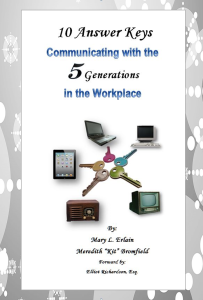Excerpt from “Empowering the Multi-Generational Workforce” 
Boomers (1946-1964)
- Ambitious
- Strong work ethic
- Loyal to careers and employers
- Optimistic
- Tendency to be workaholics
- Personal gratification
- Heroes
- Gandhi
- Martin Luther King, Jr.
- Mother Theresa
- President John F. Kennedy
- Jacqueline Kennedy
- Senator Robert F. Kennedy
- Defining Events
- Vietnam War
- Woodstock
- Women’s Rights
- Watergate
- Civil Rights Movement
- Birth of Television
- Assassinations of:
- John F. Kennedy
- Robert F. Kennedy
- Martin Luther King, Jr.
Boomers grew up in a time of dramatic social change. It is possible to divide this generation into two subsets.
- Born prior to 1956: Cuban Missile crisis, assassinations of John Kennedy, Robert F. Kennedy, and Martin Luther King, Jr., walk on the moon, Vietnam draft, anti-war protests, civil rights movements, riots, and Woodstock are events that epitomized the dramatic cultural changes of the 1960’s. Thus, this subset has a free-spirited, social cause oriented, experimental, and individualistic tendencies.
- Born 1956-1964: Watergate, Nixon’s resignation, the oil embargo, raging inflation, gas shortages, the Cold War, Jimmy Carter, Ronald Reagan, and Live Aid are the events that created this subset of Boomers to be less optimistic, tend to distrust government, and possess a cynical.
Boomers used to be the largest generation in the workplace, not so as of 2015. Boomers make up about 29% of the workforce. If you are marketing to the Boomers, determine what segment of the boomers is most likely to find value in what you are offering. Show that you care and understand this generation. Your value proposition will not be successful if it contains a hard sell approach. The Boomers need to see benefit in what you have to offer.
Here are some key excerpts from the “10 Answer Keys, Communicating with the 5 Generations in the Workplace” book.
Boomers also have a strong work ethic, but not to the degree of a Traditionalist. If they felt that the job was not meeting their needs, it was not unusual for them to start looking for something better. Usually they would not quit a job until they had something better. That would be foolish as far as they were concerned. They believed in hard work and doing a good job but not at the expense of their family or their health. They thought nothing about needing days off or using up all their sick and vacation days. It was a job, but if something better came along, they were gone, hopefully giving at least their 2-week notice. They realized that if one job did not provide the opportunities that they sought, then another job would. Bettering themselves was a core value that would ultimately get them better jobs with increased income and benefits.
Being a responsible group, time management was important, but if they were late occasionally they did not view it as a failure on their part but rather a situational event. They were cognizant of time and the role it played, but it did not govern who they were as individuals or their job performance. Their mantra was quality time versus quantity time. If they could do the job well in half the time, they did not feel it was necessary to do filler for the remaining time.
Boomers are the open and expressive generation when it comes to their verbal skills. They were given permission to tell it like it is, and they do. They are not intimidated with authority and have a general distrust of those selling products and services. They are the generation that voiced their anger over the Vietnam War and racial segregation.
These same verbal skills came with them when they entered the work force, and they fought for things they felt were injustices. They do not take things at face value and are not afraid to question and even challenge how things are done.
They are active in their beliefs and demand to be heard. When dealing with sales and advertising, they want the “good life” and everything that comes with it. They are swayed by ads and the desire to keep up with “the Jones” and the desire to flaunt their wealth. They are open and vocal about their desire to have it all. There is very little game-playing with this group as they will speak their mind and dispense with the guessing game of what am I afraid to tell you.
Boomers non-verbal skills are not as defined because they choose to speak their feelings rather than hide behind non-verbal cues. If they don’t like something, they tell it rather than roll their eyes or cross their arms. If angered or upset, they would rather confront than retreat. They will leave an area when bored or upset rather than sit through a presentation with their arms crossed.
If someone says something that they feel is wrong or against what they feel is true, they will confront them. They would prefer you to be honest and straight with them. Making them look for visual cues in your body language can hinder your communication with them. They understand the various cues and will call someone on it if they appear bored or angry or emotionally unavailable based on their body language.
Boomers, on the other hand, were the first generation in which leadership was embraced and thinking by staff members was encouraged. Bottom lines, competitiveness, and new ideas were starting to rear its head. Women started to make an appearance, desiring to change things in the workplace and to find their place in management. Management was soon to be seen moving on so that a new leadership style could emerge. No longer was the prevalent message “we do it this way or you’re fired” communicated to staff members, but rather “let me hear your ideas” was the new message. Suggestion boxes on how to make the workplace better were introduced, and great ideas were rewarded with bonuses and promotions. Management teams were encouraged to attend leadership classes and seminars. Coaches were hired to analyze work situations to determine how individuals could work better as a team. The team concept of management and leadership appeared with more frequency as organization owners realized that getting everyone involved made an organization more productive. The next generation saw entire organizations take these concepts to higher levels. Apple and Microsoft were some of the leading innovators of this concept of total staff member involvement, and the results sparked a revolution around the world.

Recent Comments